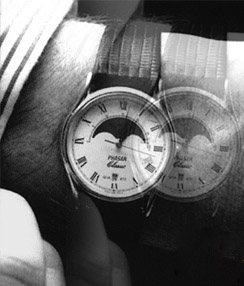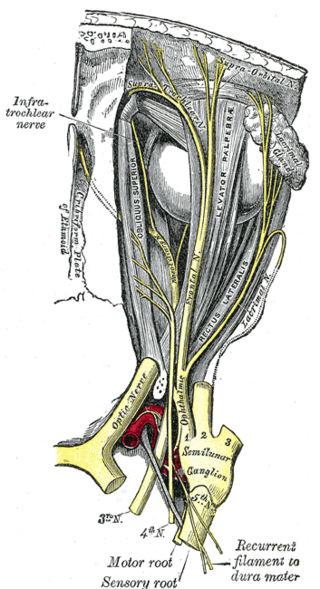
Ophthalmology is a clinical and surgical specialty within medicine that deals with the diagnosis and treatment of eye disorders. A former term is oculism.

Micropsia is a condition affecting human visual perception in which objects are perceived to be smaller than they actually are. Micropsia can be caused by optical factors, by distortion of images in the eye, by changes in the brain, and from psychological factors. Dissociative phenomena are linked with micropsia, which may be the result of brain-lateralization disturbance.
Photophobia is a medical symptom of abnormal intolerance to visual perception of light. As a medical symptom, photophobia is not a morbid fear or phobia, but an experience of discomfort or pain to the eyes due to light exposure or by presence of actual physical sensitivity of the eyes, though the term is sometimes additionally applied to abnormal or irrational fear of light, such as heliophobia. The term photophobia comes from the Greek φῶς (phōs), meaning "light", and φόβος (phóbos), meaning "fear".

Visual snow syndrome (VSS) is a form of visual hallucination that is characterized by the perception of small, flickering dots throughout the visual field. It is present in all conditions of illumination. The dots remain individual and do not clump together or change in size. Visual snow exists in two forms: the pulse type and the broadband type.

Diplopia is the simultaneous perception of two images of a single object that may be displaced horizontally or vertically in relation to each other. Also called double vision, it is a loss of visual focus under regular conditions, and is often voluntary. However, when occurring involuntarily, it results in impaired function of the extraocular muscles, where both eyes are still functional, but they cannot turn to target the desired object. Problems with these muscles may be due to mechanical problems, disorders of the neuromuscular junction, disorders of the cranial nerves that innervate the muscles, and occasionally disorders involving the supranuclear oculomotor pathways or ingestion of toxins.
Neuro-ophthalmology is an academically-oriented subspecialty that merges the fields of neurology and ophthalmology, often dealing with complex systemic diseases that have manifestations in the visual system. Neuro-ophthalmologists initially complete a residency in either neurology or ophthalmology, then do a fellowship in the complementary field. Since diagnostic studies can be normal in patients with significant neuro-ophthalmic disease, a detailed medical history and physical exam is essential, and neuro-ophthalmologists often spend a significant amount of time with their patients.
Anterior ischemic optic neuropathy (AION) is a medical condition involving loss of vision caused by damage to the optic nerve as a result of insufficient blood supply (ischemia). This form of ischemic optic neuropathy is generally categorized as two types: arteritic AION, in which the loss of vision is the result of an inflammatory disease of arteries in the head called temporal arteritis, and non-arteritic AION, which is due to non-inflammatory disease of small blood vessels.

Ischemic optic neuropathy (ION) is the loss of structure and function of a portion of the optic nerve due to obstruction of blood flow to the nerve. Ischemic forms of optic neuropathy are typically classified as either anterior ischemic optic neuropathy or posterior ischemic optic neuropathy according to the part of the optic nerve that is affected. People affected will often complain of a loss of visual acuity and a visual field, the latter of which is usually in the superior or inferior field.
Toxic and nutritional optic neuropathy is a group of medical disorders defined by visual impairment due to optic nerve damage secondary to a toxic substance and/or nutritional deficiency. The causes of these disorders are various, but they are linked by shared signs and symptoms, which this article will describe. In several of these disorders, both toxic and nutritional factors play a role, acting synergistically.

Hemianopsia, or hemianopia, is a visual field loss on the left or right side of the vertical midline. It can affect one eye but usually affects both eyes.

Nystagmus is a condition of involuntary eye movement. People can be born with it but more commonly acquire it in infancy or later in life. In many cases it may result in reduced or limited vision.
The Journal of Clinical Neuroscience is a bimonthly peer-reviewed medical journal covering the discipline of neurosurgery and neurology. It was established in 1994 and is published by the Elsevier imprint Churchill Livingstone. It is the official journal of the Asian Australasian Society of Neurological Surgeons. The editor-in-chief is Andrew H. Kaye.

Bonnet–Dechaume–Blanc syndrome, also known as Wyburn-Mason syndrome, is a rare congenital disorder characterized by arteriovenous malformations of the brain, retina or facial nevi. The syndrome has a number of possible symptoms and can, more rarely, affect the skin, bones, kidneys, muscles, and gastrointestinal tract. When the syndrome affects the brain, people can experience severe headaches, seizures, acute stroke, meningism, and progressive neurological deficits due to acute or chronic ischaemia caused by arteriovenous shunting.

Current Eye Research is a medical journal covering all areas of ophthalmology. Areas covered include: clinical research, anatomy, physiology, biophysics, biochemistry, pharmacology, developmental biology, microbiology, and immunology

Seminars in Ophthalmology is a peer-reviewed medical journal which publishes clinically oriented reviews on the diagnosis and treatment of ophthalmic disorders. Each issue focuses on a single topic, with a primary emphasis on appropriate surgical techniques.

The University of Utah School of Medicine is located on the upper campus of the University of Utah in Salt Lake City, Utah. It was founded in 1905 and is currently the only MD-granting medical school in the state of Utah.
David Glendenning Cogan was an American ophthalmologist.
Frank Burton Walsh was a Canadian-American ophthalmologist known for his work in neuro-ophthalmology. For most of his career, Walsh worked as a neuro-ophthalmologist at the Wilmer Eye Institute of Johns Hopkins Hospital. Walsh is best known for his textbook Clinical Neuro-Ophthalmology, which contains a compilation of Walsh's case reports and the conclusions he drew from them. Originally published in 1947, the textbook has many updated versions and is still a premier text in the field of neuro-ophthalmology. Walsh is considered by many to be the father of neuro-ophthalmology due to his contributions to the field.

George Ian Scott CBE, FRSE, FRCSEd was a 20th-century Scottish ophthalmic surgeon who in 1954, became the first holder of the Forbes Chair of Ophthalmology at the University of Edinburgh. He specialised in neuro-ophthalmology, studies of the visual fields and diabetic retinopathy. He was President of the Royal College of Surgeons of Edinburgh from 1964 to 1967, Surgeon-Oculist to the Queen in Scotland from 1965 and president of the Ophthalmological Society of the United Kingdom from 1970 to 1972.
Robert Barry Daroff is a pioneer of ocular motor research. He is a neurologist in Cleveland, Ohio, connected to University Hospitals Cleveland Medical Center. He is also Professor and Chair Emeritus of Neurology at Case Western Reserve University School of Medicine.











